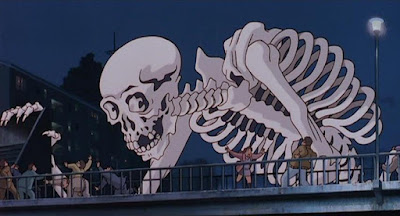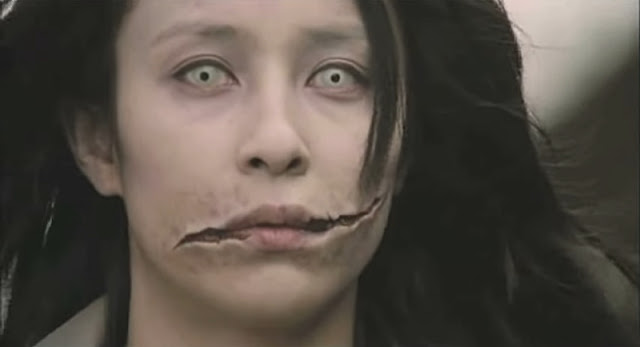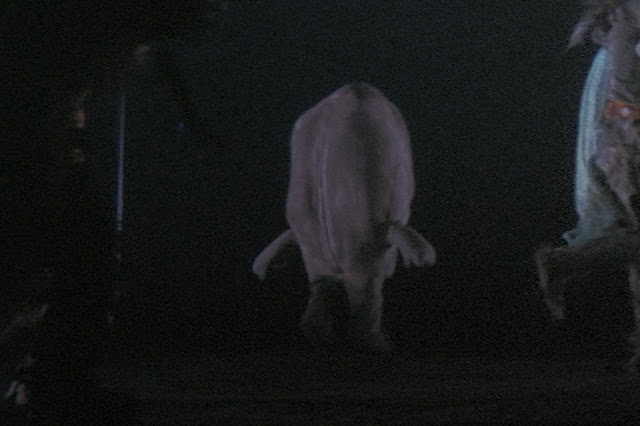I
love yokai! There, I said it. Ever since I was introduced to these fanciful and
frightening beings in all their cinematic glory, I can’t get enough of the
things that go bump in the night. But what exactly are yokai? These reclusive,
elusive creatures belong to a broad category of mythical spirits (or monsters)
that inhabit every corner of the Japanese countryside (and in some urban
areas). Part cryptid, part urban legend, yokai are an integral component of
Japanese folklore and pop culture. Chances are, if you’ve watched many Japanese
movies, anime, or manga, you’ve seen yokai (sometimes translated as spirits,
monsters, demons, or goblins) already in one form or another. But what are
they?
There are literally hundreds of yokai, as diverse as the habitats they represent. Their temperament ranges from harmless to deadly. Many are tricksters who only want to frighten people away, but encounters with some can result in a nasty end. While the variety of yokai are far too numerous to cover here, I’ve chosen to focus on a baker’s dozen of the more popular examples that you’re most likely to encounter on your TV screen. What follows is a brief guide to yokai in the movies and where you can view them. Happy hunting!
Kappa (Water Sprite)
By far one of the most widely known (and frequently depicted) yokai are kappa. While there are several variations, the stereotypical kappa is humanoid in appearance, but with a turtle’s beak and shell, as well as a ceramic plate on top of its head that must remain wet to maintain its vitality. Kappa are characterized by their fondness for sumo wrestling, eating cucumbers (Sushi fans might recognize the “kappa roll,” which includes – you guessed it.), and excessive flatulence. Although they’re generally depicted as benign, they have a mischievous streak, with a tendency to drag people into the waterways where they live. Some are also thought to attack the posterior of swimmers for a mythical organ within the colon.
Where
can you see them?
You don’t have to look very hard to find kappa in Japanese fantasy films. They’re featured prominently in Yokai Monsters: Spook Warfare (aka: The Great Yokai War) (1968) and Takashi Miike’s remake, The Great Yokai War (2005). In Summer Days with Coo (2007), they’re the star attraction. And before The Shape of Water (2017) introduced us to the possibility of (ahem) human-monster relations, the surprisingly charming Underwater Love (2011) featured the yokai in quite possibly the only Kappa-themed pinku musical. And last but definitely least, an “ordinary” kappa grows to extraordinary proportions in the middling Kaijū eiga-spoof, Death Kappa (2010).
Onibaba (Demon Hag)
This is one yokai you don’t want to mess with. Appearing as an old woman, the Onibaba feasts on the livers of unborn children and the flesh of wayward travelers. Legend has it that she started out as a human being, but unfortunate circumstances forced her into existence as a supernatural entity.
Where
can you see them?
Look no further than Onibaba (1964), which approaches the legendary yokai from a more pragmatic perspective.
Perhaps the uncanniest yokai of them all are the Nopperabo, proving that when it comes to frights, less is sometimes more. They look normal enough until they turn around, revealing a face completely devoid of features (“Did they look like this?”). They’re not inherently dangerous like the Onibaba, but delight in creeping out unsuspecting humans who happen to cross their path.
Where can you see them?
Examples
of these faceless wonders can be found in Along with Ghosts (1969) and Pom
Poko (1994).
My personal favorite yokai isn’t dangerous or especially fearsome, but relies on the element of surprise. A discarded oiled-paper umbrella takes on life of its own, sporting one large eye, a single shapely leg where the handle should be, and a solitary sandal. A natural-born trickster, the Kara-kasa likes to drop in on people unexpectedly. If their appearance isn’t enough to send someone running, they might provide additional enticement to vacate the premises with a sloppy lick from their serpentine tongue.
Where can you see them?
You’ll
find examples of the kara-kasa in Yokai Monsters: Spook Warfare (1968)
and 100 Monsters (1968). Also, watch for cameos in Pom Poko (1994)
and Sakuya: Slayer of Demons (2000).
At first glance, the Rokurokubi appear to be a normal human being (much like the nopperabo), but just when you’re lulled into a false sense of security, their true nature appears. The rokurokubi (who are uniformly female) enjoy scaring men out of their wits (and sometimes their life essence) with their absurdly long, twisty necks.
Where can you see them?
Rokurokubi
are nearly as prevalent in films as kappa, appearing in Yokai Monsters: Spook
Warfare (1968), 100 Monsters, The Great Yokai War (2005), and (briefly) in Pom
Poko (1994).
Yuki-Onna (Snow Woman)
One of the more dangerous yokai, the Yuki-Onna resembles an attractive woman with an extremely pale complexion. They roam the snowy countryside looking for victims. Anyone unlucky enough to encounter them runs the risk of having his or her life energy drained and freezing to death.
Where can you see them?
The
Yuki-Onna enjoyed her time in spotlight in a segment of Kwaidan (1964), and
starred in her own film, The Snow Woman (1968). She also makes a guest appearance
in The Great Yokai War (2005).
One of the more recent yokai, Kuchisake Onna is the stuff of urban legend (and nightmares). Pray you never run into her. The lower portion of her face is concealed by a surgical mask or other piece of cloth, which conceals the fact that her mouth is slit from ear to ear in the hideous approximation of a smile. There’s no correct answer to her challenge, “Am I pretty?” If you answer “yes,” she follows you home, where a violent death awaits. If the answer is “no,” she reveals her visage, slashing the victim’s face in a grotesque mimicry of her disfigurement.
Where can you see them?
Perhaps not the best representation of the Kuchisake Onna, but Carved: The Slit-Mouthed Woman (2007) has its unsettling moments.
Tanuki (Raccoon Dog)
Unlike the other yokai on this list, Tanuki have real-life counterparts, inhabiting the Japanese countryside, albeit in dwindling numbers. Not really raccoons, but a member of the canine family, folklore suggests these critters possess supernatural properties. With their reputation as natural-born tricksters, Tanuki enjoy deceiving humans with their shape-shifting abilities. They’re also known for their enormous testicles (I didn’t make that up), as depicted by the ubiquitous statuettes around their native country.
Where can you see them?
Look
no further than the bittersweet Pom Poko (1994), an entire movie devoted
to the wily, fun-loving creatures, who wage a losing war with humans
encroaching on their habitat.
While they’re not exactly the rock stars of the yokai world, Nuppeppo (which is also Japanese slang for someone who wears too much makeup), you don’t have to look too hard to find them in the cinematic world (the real world is another story). These bipedal creatures are vaguely human in shape, but resemble a squat, featureless blob with legs, with a tendency to wander around abandoned places and graveyards.
Where can you see them?
You
can find an example of the Nuppeppo in Yokai Monsters: Spook Warfare (1968) and 100 Monsters (1968).
Tengu are supernatural mountain spirits that resemble men with wings and long noses. As with many yokai, there are many variations. They’re ambiguous in nature, however, as portrayed in film, they’re generally benevolent and monk-like.
Where can you see them?
One
appears in The Great Monster War (2005), although with a blue complexion
(rather than red).
The Wanyudo makes it presence known in spectacular fashion: as a fiery spinning wagon wheel with the face of a priest in the middle. This yokai has a vengeful streak, ready to run over whomever is foolish enough to get in their way. The Wanyudo dines on the souls of its unfortunate victims, subsequently dragging their bodies to hell. Villagers protect themselves against the Wanyudo by adorning their doors with a talisman.
Where can you see them?
You
can catch a glimpse of the Wanyudo in The Great Yokai War (2005), and
briefly in Pom Poko (1994).
Abura Sumashi (Oil Presser)
This unassuming yokai is short, with a huge, boulder-like head, and dressed in a straw raincoat. Not much is known about the Abura Sumashi, however, their distinctive appearance is attributed to a curse for stealing oil when they were still in human form.
Where can you see them?
An
Abura Sumashi appears as the nominal leader of the yokai in Yokai Monsters:
Spook Warfare (1968) and The Great Yokai War (2005).
Mokumokuren (Haunted Shoji Screen)
While they’re among the least threatening of yokai, Mokumokuren’s harmless nature doesn’t diminish their ability to creep you out. Like some of their yokai brethren, Mokumokuren are a prime example of taking something inanimate and innocuous and turning it into something vaguely sinister. A prevalent aspect of traditional Japanese architecture is the sliding paper (shoji) screen. Now imagine said screen adorned with multiple pairs of eyes, and you’ve got a Mokumoku-ren. If you ever felt you were being watched when you were alone, this could be the culprit.
Where can you see them?
You can spot the offending décor in The Great Yokai War (2005)
Sources
for this article: Yokai Attack! The Japanese Monster Survival Guide, by
Hiroko Yoda and Matt Alt; Strange Japanese Yokai, by Kenji Murakami; The
Book of Yokai, by Michael Dylan Foster; The Night Parade of One Hundred
Demons, by Matthew Meyer; Japandemonium Illustrated, The Yokai
Encyclopedias of Toriyama Sekien
















A fun, frightening and fascinating guide to yokai! Some are truly made from the stuff of nightmares, such as the faceless ones. Then some are positively Goofy, like the umbrella one, your favorite. I have never watched a lot of Japanese fantasy, but quite a few things familiar, either from your other reviews or maybe there are similar creatures in other cultures.
ReplyDeleteThanks, John! There are so many different yokai, I could go on and on... It would be interesting to do a comparative study between yokai and mythical creatures from other countries (such as U.S. cryptids!). Yokai Attack! The Japanese Monster Survival Guide, by Hiroko Yoda and Matt Alt is a great little book to start with, if you ever want to read more about them.
DeleteWhat a wonderful introduction to this hugely imaginative and frightening world of creatures! By contrast, American cryptids are positively pedestrian. It looks like Pom Poko highlights quite a few Yokai, and might be a good starting point for the uninitiated.
ReplyDeleteHi Brian! Thanks for the kind words. Pom Poko is indeed a great place to start. You also can't go wrong with Yokai Monsters: Spook Warfare. Besides featuring an encyclopedic array of yokai, they're both a lot of fun.
Delete